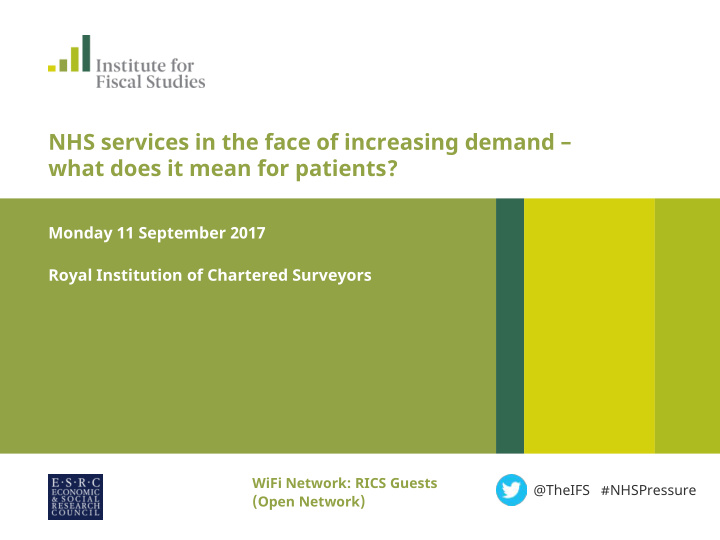



NHS services in the face of increasing demand – what does it mean for patients? Monday 11 September 2017 Royal Institution of Chartered Surveyors WiFi Network: RICS Guests @TheIFS #NHSPressure (Open Network)
The NHS in 2017 Richard Murray Director of Policy, The King’s Fund
The NHS in 2017 › The core challenge › More for less (or lots more for slightly more) › Bringing it all together
The core challenge Department of Health real terms funding and total hospital admissions, 2003/04 = 100 - Sustained (relative) 180 austerity in the NHS budget has not been 170 matched by changes in 160 activity Admissions Index value (2003/4=100) 150 - Recent NHS productivity 140 compares well to whole- Funding 130 economy activity 120 - The NHS (rather than 110 health) looks relatively 100 cheap by international standards 90 Funding: 2015/16 prices as at Dec 2016; Admissions, actual to 2015/16, NHS England `unmitigated demand’ for acute services after 2015/16
And its getting harder, not easier Annual real terms growth in health spending, 2010/11 to 2020/21, % 3.5% • Some of the 3.0% growth in recent 2.5% years was not part of the original plan 2.0% 1.5% • The Budget may 1.0% give some relief (though possibly 0.5% not much) 0.0%
What does this mean? Annual percentage increase in FTE qualified nursing, midwifery & health visiting staff • A truism that healthcare 5.00% is a service industry and 4.00% workforce accounts for the majority of 3.00% spending 2.00% • Though not one-to-one, 1.00% low spending growth means low (or negative) 0.00% 2001 2002 2003 2004 2005 2006 2007 2008 2009 2010 2011 2012 2013 2014 growth in staff -1.00% • 2015-16 saw slower -2.00% growth in nursing staff (around 1%) Source: NHS Workforce Statistics in England, Non-medical staff - 2004-2014 and earlier years, NHS Digital. • Nursing numbers are now falling
What does it mean: performance A&E 4 hour standard, Type 1 units. Aug 2010 to July 2017 100.0% • Ambulance and cancer waiting 95.0% times targets also in breach 90.0% 85.0% 80.0% • Concerns on performance 75.0% 70.0% outside of the acute sector have 65.0% been rising 60.0% • Aug-10 Dec-10 Apr-11 Aug-11 Dec-11 Apr-12 Aug-12 Dec-12 Apr-13 Aug-13 Dec-13 Apr-14 Aug-14 Dec-14 Apr-15 Aug-15 Dec-15 Apr-16 Aug-16 Dec-16 Apr-17 Delayed Transfers of Care • General practice 18 weeks performance, `% still waiting’, Aug 2010 to June 2017 • Mental health • 96.0% Strategies or initiatives now 94.0% in all of these areas 92.0% 90.0% • Though A&E and 18-weeks 88.0% looking more stable than they 86.0% have for years 84.0% Aug-10 Dec-10 Apr-11 Aug-11 Dec-11 Apr-12 Aug-12 Dec-12 Apr-13 Aug-13 Dec-13 Apr-14 Aug-14 Dec-14 Apr-15 Aug-15 Dec-15 Apr-16 Aug-16 Dec-16 Apr-17
More for less: the NHS and social care response • Population-based, integrated care STPs/ACSs • 44 Footprints and new ACSs being formed • Builds on Vanguard experience Efficiency • Carter, Naylor Review, GIRFT and Right Care • Backed up by central controls and incentives and costs • And action on costs – pay and prices • Focus on A&E for now The offer • First moves on access to NICE-recommended drugs and procedures/medicines of low value
Bringing it all together - How to balance: - Short term agendas on finance and performance - Long term agendas on relationship building and moving to more integrated systems in planning (STPs) and delivery (Vanguards et al) - But there are strengths: - There is a platform for action - The direction of travel is much less contentious than it was, for example in the 2012 Act or in the market+choice reforms of the previous decade - The public care - Are we missing something? - The Noughties looked to raise activity quickly – a lot of effort went into capacity planning and the profiling of demand - Some of this was forgotten in the final years of plenty - As the balance between capacity and demand again gets tighter understanding this relationship may provide a (quicker) win
Recommend
More recommend